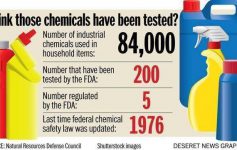This week, I posted my top holistic and wellness news on the topics of nutrigenomics, health, medication updates, and functional and naturopathic medicine for January 2015. The goal of my Top Reads is to keep my readers current with a skim-through and reader-friendly overview of health headlines from the previous month.
This week, for my saratoga.com readers, I highlight some of the top articles linking environment exposures to health outcomes.
Chemicals Linked To Earlier Menopause
A
cross-sectional survey of 31,575 females who were menopausal and over 30
years of age was done using National Health and Nutrition Examination
Survey (NHANES) data from 1999 to 2008. The purpose was to assess levels
of 111 endocrine disrupting chemicals (EDC) and their exposure impact
on onset of age of menopause. (Various confounding factors were
accounted for):
This
analysis examined 111 EDCs and focused on known reproductive toxicants
or chemicals with half-lives >1 year. Women with high levels of
B-hexachlorocyclohexane, mirex, p,p’-DDE,
1,2,3,4,6,7,8-heptachlorodibenzofuran, mono-(2-ethyl-5-hydroxyhexyl) and
mono-(2-ethyl-5-oxohexyl) phthalate, polychlorinated biphenyl congeners
-70, -99, -105, -118, -138, -153, -156, -170, and -183 had mean ages of
menopause 1.9 to 3.8 years earlier than women with lower levels of
these chemicals. EDC-exposed women were up to 6 times more likely to be
menopausal than non-exposed women.
Sources:
- Washington
University in St. Louis. Earlier menopause linked to everyday chemical
exposures. ScienceDaily. 28 January 2015.
www.sciencedaily.com/releases/2015/01/150128141417.htm. - Grindler
NM, Allsworth JE, Macones GA, Kannan K, Roehl KA, et al. Persistent
Organic Pollutants and Early Menopause in U.S. Women. PLoS ONE. 2015; 10(1): e0116057. doi:10.1371/journal.pone.0116057
Glyphosate Exposure Was Correlated To Kidney Disease (CKDu) In Sri Lanka
“A
case control study was carried out in Padavi-Sripura hospital in
Trincomalee district. CKDu patients were defined using health ministry
criteria. All confirmed cases (N = 125) fulfilling the entry criteria
were recruited to the study. Control selection (N = 180) was done from
people visiting the hospital for CKDu screening. Socio-demographic and
data related to usage of applying pesticides and fertilizers were
studied. Drinking water was also analyzed using ICP-MS and ELISA to
determine the levels of metals and glyphosate.”…
The study found that the highest risk for CKDu occurred in participants who:
- Drank well water (2.52 fold increased risk)
- Had a history of drinking water from an abandoned well (5.43 fold increased risk)
- Sprayed glyphosate (5.12 fold increased risk)
- Were male (4.69 fold increased risk versus women)
Sources:
- Ji,
S. Roundup Herbicide- A Killer Kidney? Green Med Info. January 19,
2015.
http://www.greenmedinfo.com/blog/global-fatal-kidney-disease-linked-to-roundup-herbicide - Drinking
well water and occupational exposure to Herbicides is associated with
chronic kidney disease, in Padavi-Sripura, Sri Lanka. Environmental Health. 2015, 14:6 doi:10.1186/1476-069X-14- - Glyphosate,
Hard Water and Nephrotoxic Metals: Are They the Culprits Behind the
Epidemic of Chronic Kidney Disease of Unknown Etiology in Sri Lanka? J. Environ. Res. Public Health .2014, 11(2), 2125-2147; doi:10.3390/ijerph110202125
Study Finds Glyphosate Increases Psuedomonas Growth
The results of the new study indicate that
when exposed to varying concentrations of both glyphosate (a common
contaminant found in GM agricultural runoff) and oxygen,
both the aerobic the anaerobic and biofilm forming strains of this bacteria can
thrive:
Sources:
- Ji,
S. Roundup Weedkiller Feeds Antiobiotic Resistant Bacteria. Green Med
Info. January 2, 2014.
http://www.greenmedinfo.com/blog/roundup-weedkiller-feeds-antibiotic-resistant-bacteria-study-finds - Lima IS, Baumeier NC, Rosa RT, Campelo PMS, Rosa EAR. Influence of glyphosate in planktonic and biofilm growth of Pseudomonas aeruginosa. Brazilian Journal of Microbiology 2014;45(3):971-975.
- Antibiotic
Susceptibilities of Pseudomonas aeruginosa Isolates Derived from
Patients with Cystic Fibrosis under Aerobic, Anaerobic, and Biofilm
Conditions Clin. Microbiol. October 2005.
More Links to Environmental Toxicants and ADHD
A
study that analyzed survey results of 19,940 respondents found an
association of exposure to prenatal environmental tobacco smoke (ETS)
and alcohol use with ADHD risk in offspring.
The
differences between the groups were statistically significantly
(P<0.0001). This result shows that simultaneous exposure to ETS and
alcohol during pregnancy increases the risk of ADHD.
Source:
The effects of prenatal exposure to alcohol and environmental tobacco
smoke on risk for ADHD: A large population-based study. Psychiatry Research. January 2015; 225(1-2):164-168. http://www.sciencedirect.com/science/article/pii/S0165178114008658
For more holistic health news, make sure to read the rest of my top reads on my homepage.



